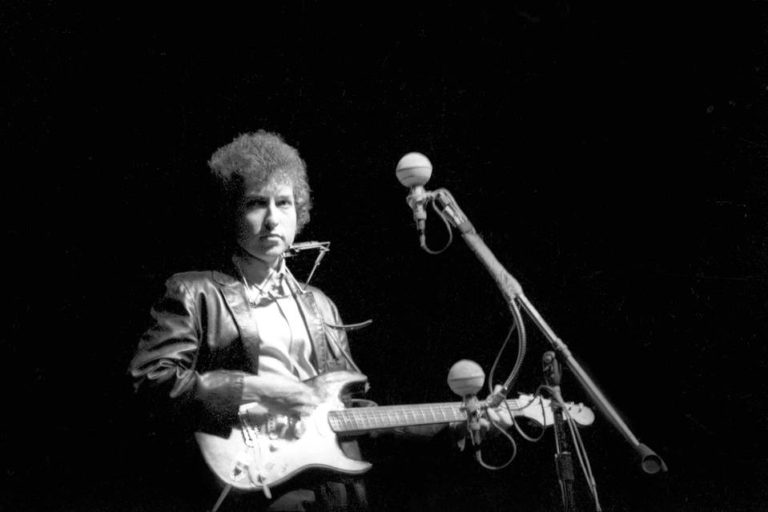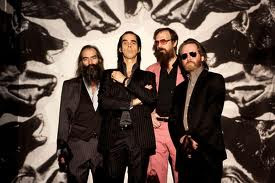When did rock & roll get hip again?
UPDATED November 23 2017
The difference between rock ‘n’ roll and rock & roll (or rock and roll)?
For a long time now, it’s been fashionable to describe great rock music as rock & roll. But have you ever wondered when this second era of rock & roll began?
And have you noticed the general shift in spelling, from the ‘rock ‘n’ roll’ of the 1950s, to the ‘rock & roll’ or ‘rock and roll’ we call such music now? While the term has never been set in stone, let’s examine when and how the change took place.
When the Beatles first exploded through pop music’s letterbox, in late 1962, rock ‘n’ roll had become unhip and passé, generally obliterated by ultra-boring, middle-of-the-road, lightweight elevator music. Quiffs, tight jeans, shaking hips and great rocking music had gone out of fashion. Being just a kid, I was baffled where all this magnificent music had gone.
My last great rock ‘n’ roll record.
The last great rock ‘n’ roll record I remember being released was two-and-a-half years before the Beatles changed music forever. This track was ‘Shakin’ All Over’, written by Johnny Kidd, and recorded by the great Johnny Kidd and his Pirates band at London’s Abbey Road, in May 1960.
‘Shakin’ All Over’ shook Britain all over, that summer of 1960, hitting number one in August. It wasn’t marketed as rock ‘n’ roll back then, of course, simply as pop music. For some reason, the single was only released in the UK. Since you’ve possibly only heard cover versions, here’s the Johnny Kidd original:
The Beatles and rock and roll’s 1964 revival.
In 1964, the Beatles recorded and released their fourth studio album ‘Beatles for Sale’ featuring their cover of Chuck Berry’s 1957 classic, ‘Rock and Roll Music’, a long-time staple in their stage shows. Note how Chuck called the music “Rock and Roll”.
With George Martin on piano, ‘Rock and Roll Music’, truly established John Lennon as one of the world’s great rock & roll singers. It was a favourite track on a Beatles album that broke sales records in the UK and USA in 1965, and remained a stage favourite. Indeed, the Beatles opened with Rock and Roll Music at their last ever concert, on August 29th 1966 in San Francisco.
Kidd’s rock ‘n’ roll classic covered – as rock & roll.
With old time rock ‘n’ roll music back in vogue, (thanks to the Beatles, for whom it went away), Canadian band Guess Who hit the U.S. top 40 in 1965, with their cover of Johnny Kidd’s 1960 rock ‘n’ roll classic, ‘Shakin’ All Over’. In Australia, another cover, by Normie Rowe, established Kidd’s ‘Shakin’ All Over’ as Down Under’s bestselling single for 1965, outselling even the Beatles’ ‘Rock and Roll Music’ (at number four).
Rowe’s ‘Shakin’ All Over’, ultimately, became one of the biggest selling singles of the 1960s in Australia. Naturally, most Aussies still think it’s an Australian song.
In 1966, the American country rock band, the Byrds, recorded ‘So You Want to be a Rock ‘n’ Roll Star’ – sticking to 1950s-style spelling. To my knowledge, this was the first time rock ‘n’ roll star was mentioned as a concept. Released in January 1967, the Byrds’ single reached 29 in the U.S. hot 100. Here it is:
In September that year, U.S. folk rock trio Peter, Paul and Mary had a number nine Billboard singles hit in 1967, with ‘I Dig Rock and Roll Music’ released in September. That’s 50 years ago, can you believe.
By 1967, rock & roll was beginning to mean rock music, as we know it today, rather than its original 1950s form. In 1968, the Rolling Stones famously organised an event they called, ‘The Rolling Stones’ Rock and Roll Circus’. Appearing with the Stones were John Lennon, Yoko Ono, the Who, Taj Mahal, Marianne Faithful, Jethro Tull (with Sabbath’s Tony Iommi on guitar), and a supergroup, the Dirty Mac, made up of Eric Clapton, Keith Richards, John Lennon and Mitch Mitchell, drummer of the Jimi Hendrix Experience.
Brian Jones’ appearance with the Stones was the last he ever made. Unfortunately, the resulting film was canned by the Stones due, it’s said, by their being totally upstaged by both the Who and American bluesman, Taj Mahal. It was finally released in 1996 but the seed of rock & roll as a resurrected genre was going mainstream.

The birth of “Underground” music
By the late 1960s, the hip press was calling any music that wasn’t pop: ‘underground’, possibly after Michael Leigh’s 1963 paperback, ‘The Velvet Underground’. A book about sexual perversion, this highlighted the sexual revolution then being spearheaded during the Swinging Sixties throughout the western world. The seminal American art rock band, The Velvet Underground, took their name from this book.
By 1970, underground music was being called progressive rock, as a new way of differentiating it from pop, which was still the establishment’s generic term for all modern music aimed at under 30s. Remember, in 1970, you were considered old at 30.
Various rock sub-genres had now developed, many of which were virtually interchangeable with each other, just as ragtime, blues and jazz were similarly interchangeable from 1912 to around 1930. I’m listing five here, but I’m sure you can think of more.
- Blues-rock (ie: Cream/Led Zeppelin) was interchangeable with hard-rock (Black Sabbath/Free).
- Country-rock (Buffalo Springfield/Jefferson Airplane) was interchangeable with folk-rock (Byrds/Lovin’ Spoonful).
- Soft-rock (Simon and Garfunkel/Crosby, Stills and Nash) was interchangeable with folk-rock (Peter, Paul & Mary/Mamas & Papas).
But all this new-style rock still came under the umbrella of pop music, as far as the older generation was concerned.
4. Psychedelic-rock (Beatles/Beach Boys) was interchangeable with art-rock (Pink Floyd/ Jimi Hendrix Experience).
5. Jazz-rock (Chicago/Blood, Sweat & Tears) was interchangeable with jazz-fusion (Mothers of Invention/Soft Machine).
And, so it went on, with every band fitting into any number of musical categories, depending on the musical style of track they were playing. Those 1960s genres, today, of course, are also categorised by radio stations as classic-rock.
Rebranding puts the ‘and’ into rock and roll
1970 was the year the Velvet Underground recorded the Lou Reed song ‘Rock & Roll’ – a song, he said, about how radio influenced him.
Then in 1971, Led Zeppelin recorded their classic ‘Rock and Roll’, which peaked at 38 in America’s Cashbox singles chart in 1972. I believe the secret Rolling Stone, pianist Ian Stewart, was on piano for this one.
In 1971, an English band led by ex-Zombie keyboard player, Rod Argent, recorded, ‘God Gave Rock n’ Roll to You’, in London. Worked as their record company publicist at the time, I couldn’t understand why the release date was put back to 1973. It charted in the UK, but I don’t think it was even released in America. Of course, Kiss covered the song in 1991, reaching 21 on Billboard’s singles chart and becoming a Kiss classic.
Then, in 1972, London’s critically acclaimed but commercial unsuccessful, Vinegar Joe, released their “Rock’n Roll Gypsies” album. I remember being in their dressing room, with Vinegar Joe’s guitarist and co-vocalist, Robert Palmer, who wore a ragged tee-shirt, old jeans and baseball boots. Palmer later turned up as the elegantly-dressed, be-suited solo performer who won deserved Grammies both for his ‘Addicted To Love’ in 1987, then ‘Simply Irresistible’ in 1989.
David Bowie becomes a rock & roll superstar
Also in 1972, David Bowie recorded “Rock ‘n’ Roll Suicide’, the closing track on his iconic Ziggy Stardust album, which elevated Bowie out of the underground/progressive music scene to rock super-stardom in 1972.
The same elevation happened to Marc Bolan when Tyrannosaurus Rex became T-Rex. In tandem with the now-convicted paedophile, Gary Glitter, T-Rex and the Glitter Band spearheaded the new glam-rock genre into the 1970s. Indeed, Glitter’s single, ‘Rock and Roll’, made number seven on the Billboard Hot 100, as well as storming charts around the world.
We had no idea then that Paul Gadd (Glitter’s real name) was a child molester. To the contrary, he was banging a female friend of mine who was in her mid-twenties in 1972. On the subject of banging, we all know that’s how the term rock & roll started: as African-American slang for having sex. As I say in my book, ‘American Gift’, the first song acknowledging this was by a university-educated, middle-class African American, back in the Roaring 20s. She was 27-year-old Trixie Smith, later a Hollywood actress, who had a hit with ‘My Man Rocks Me (With One Steady Roll) in 1922. Here’s a 1938 version.
America’s Gift also explains when the classic rock & roll rhythm section started: the chord-strumming rhythm guitar, drums and bass. Believe it or not, this was between 1895 (when the drum trap was invented) and 1900, when horn players like Buddy Bolden were pioneering hot blues in New Orleans. Such music we now think of as jazz.
In 1934, American singing trio, the Boswell Sisters, had a hit with a song called ‘Rock & Roll’. It wasn’t rock & roll as we know it, of course, but the Boswell Sisters were the trio whom the Andrews Sisters, of WW2 fame, based themselves upon.
Funnily enough, the famous crooner, Bing Crosby, proclaimed in 1939, that the Andrews Sisters’ songs were, “rock and roll with unleashed enthusiasm tempered to strict four-four time”. Today, people think the disc jockey Alan Freed coined the term rock & roll, in 1952, but Freed simply made it popular.
Enter the Rolling Stones.
Thanks, then, to major pop hits mentioning rock & roll by Peter, Paul & Mary in 1967, and Gary Glitter in 1972, plus underground credibility via the Velvet Underground’s ‘Rock & Roll’ in 1970 and Led Zeppelin’s ‘Rock & Roll’ in 1971, the term was well on its way to making a comeback in music’s vernacular by the early 1970s.
In January 1974, David Bowie referred to the term again with ‘Rock ‘n’ Roll with Me’ for his ‘Diamond Dogs’ album. Later that year Bowie shared vocals with Mick Jagger on ‘It’s Only Rock ‘n’ Roll’, a demo originally recorded in 1974, in Ronnie Wood’s London basement, apparently inspired by Bowie’s ‘Rock ‘n’ Roll Suicide’.
Ronnie Wood was on guitar, American Willie Weeks on bass, and former Small Faces/Faces Kenney Jones on drums. Though not quite a member of the Rolling Stones, this was the first Stones’ song Wood contributed to. When released as a single by the Rolling Stones in 1974, ‘It’s Only Rock ‘n’ Roll’ made the British Top Ten and number 16 in the USA.
The video, with the Stones in sailor suits, being buried in bubbles, featured the last film appearance of Mick Taylor. The Stones’ album, however, ‘It’s Only Rock & Roll’ stormed the U.S. album charts at number one, and made number two in the UK album charts.
As Mick Jagger has noted, ‘The title has been used a lot by journalists. The phrase (It’s Only Rock & Roll’) has become a big thing.”
According to the Encyclopaedia Britannica, rock & roll now refers either to a style of popular music originating in America in the 1950s, prior to its development by the mid-1960s into ‘the more encompassing international style known as rock music.
So what exactly is rock music?
According to the British academic Dr. Simon Frith, rock is “Something more than pop, something more than rock & roll.” Rock musicians combine, the professor says, “an emphasis on skill and technique with the romantic concept of artistic expression, original and sincere.” So, when did rock music start being called rock, as well as rock & roll? And when did they begin to replace the now out-dated term of pop music?
Rock sub-genres continued through the 1970s, with punk-rock (Sex Pistols/Clash) being the most influential, as we know. Punk changed the attitudes of music consumers and bands alike, rocking the dynamics of the music industry if you’ll pardon the pun
From punk evolved alternative rock (Pixies/Cure) in the 1980s which, to me, had exactly the same meanings as underground or progressive rock: they did not fit popular music’s mainstream.Alternative-rock was used to describe everything from indie-pop (put out by independent record labels) to Britpop in the UK (Blur/Oasis) and grunge (Nirvana/Pearl Jam) in America.

Like hard-rock, blues-rock and heavy metal – and like ragtime, blues and jazz half a century earlier – the terms ‘alternative’ and ‘indie’ were interchangeable for a time.
Alternative and indie rock lost its shine in the 1990s when its acts became mega-successful.
Around the year 2000, the expression ‘rock’ seems to me to have become a blanket term for all popular music that features electric guitars and a beat. And, of course, the description ‘rock star’ has come to mean anyone super-successful, from ‘rock star’ chefs and lawyers to ‘rock star’ politicians and church officials.
And any accountant who saves such celebrities paying full income tax is known, I’m sure, these days, as a ‘rock star’ accountant.
Who said rock & roll wouldn’t last?







You’ve done it again, Paul – Great blog – Thoroughly enjoyed it!!!
Thanks for letting me know, Carlos. So glad you liked it. It means a lot.